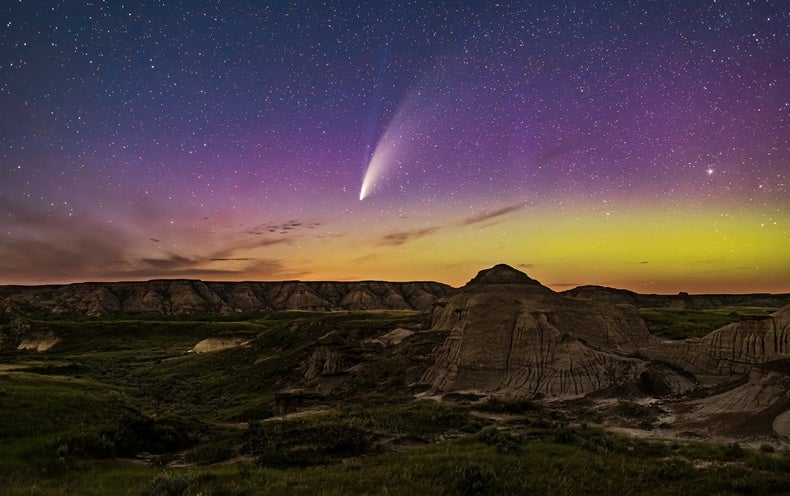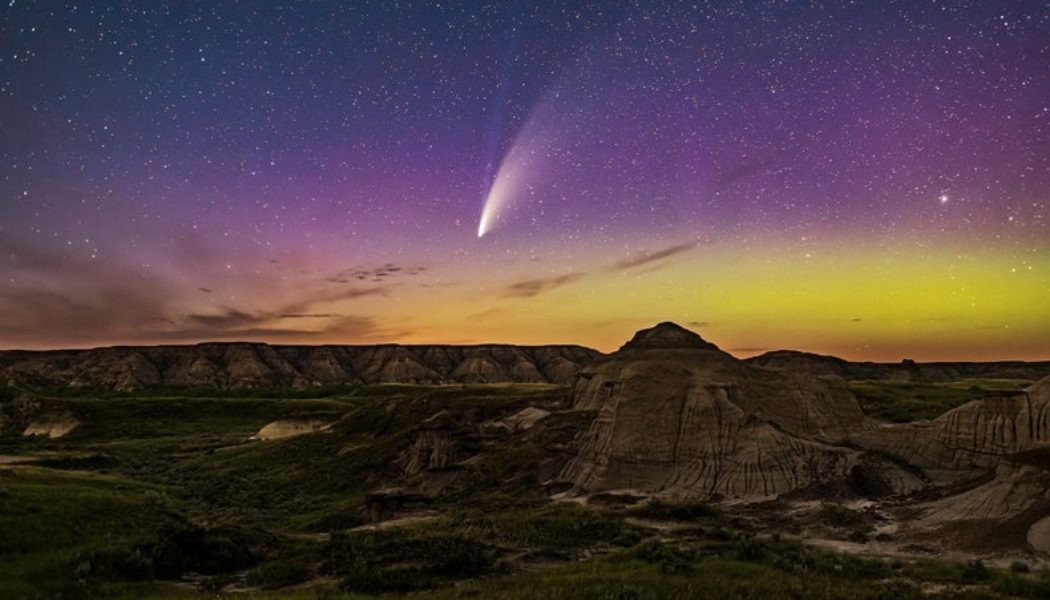
Scientists and amateur astronomers are hot on the trail of what could be the next great comet.
It was just a faint speck seen through powerful telescopes on Earth when astronomers discovered Comet C/2023 A3, also known as Comet Tsuchinshan-ATLAS, earlier this year. But despite this object’s unassuming initial appearance, its orbit was immediately eye-catching: Comet Tsuchinshan-ATLAS is on track to zip quite close to the sun and Earth alike in the autumn of 2024, setting the stage for what could be a fantastic celestial spectacle.
“Pretty much right away, it started a buzz in the comet community, because predictions were putting it all over the place in terms of how bright it could get,” says Ariel Graykowski, a planetary astronomer at the SETI Institute in Mountain View, Calif. She says current estimates suggest that Comet Tsuchinshan-ATLAS may become brighter than Comet NEOWISE, which dazzled sky watchers in 2020, and that it could even rival Comet Hyakutake, which made a stunning close approach to Earth in 1996. The most optimistic projections forecast that the newfound comet could exceed even these notable forebears by becoming as bright as Venus.
But astronomers have been disappointed by plenty of promising comets that proved underwhelming, says Quanzhi Ye, a planetary astronomer at the University of Maryland, who describes himself as “cautiously excited” about Comet Tsuchinshan-ATLAS. “Comets are like cats: they have tails; they do what they want,” Ye says. “Almost for every case, it’s not going to end the way that you predicted…. We won’t know until we get there.”
Often described as dirty snowballs, comets are the dusty, icy relics of planetary formation that were hurled to the solar system’s outskirts eons ago by gravitational interactions with Jupiter or other giant worlds. Like old leftovers forgotten at the back of your freezer, they spend most of their time inert and unnoticed in the dark. But when one approaches the inner solar system, sunlight turns some of a comet’s ice into gas in a process called sublimation, forming a fuzzy, glowing cloud called a coma. Gas from the sunbathed, sublimating ice also puffs intermingled dust away from the surface to form a distinctive, comet-trailing tail.
But different comets are made of different mixes of ice, and sublimation can be a quirky process. Comets can suddenly brighten in an outburst, fall to pieces or just fizzle out. “All these moving parts contribute to the fact that comets are very difficult to predict,” Ye says.
One key question is whether Comet Tsuchinshan-ATLAS has ever flown through the inner solar system before. If it has, it’s what scientists call a dynamically old comet—a hardened veteran of multiple close approaches to the sun that can reliably put on a show next year without falling apart. If the comet is instead a first timer, its pristine ice might be fluffier and more fragile, making it more likely to disintegrate as it ventures deeper into the inner solar system. Determining whether a comet is dynamically old or new is tricky, however, requiring an extrapolation of the object’s orbit back in time.
Ultimately, only patience will reveal precisely how Comet Tsuchinshan-ATLAS fares in the skies. But that patience won’t be idle: between now and the comet’s closest approach to the sun in September 2024 and to Earth in the following October, professional and amateur astronomers alike will have it in their sights.
For example, Graykowski works with a global network of comet-tracking amateur astronomers fostered by telescope manufacturer Unistellar. Through this network, she can check up on the comet nearly every day and rapidly obtain fresh observations in response to any sudden changes in its appearance. That combination will be powerful in monitoring the comet’s approach over the next year, she says. Network observers have already begun keeping track of the comet, even though it remains faint in their telescopes.
And in the case of Comet Tsuchinshan-ATLAS, backyard scientists may have a leg up on the professionals, Graykowski notes. That’s because throughout the time the comet is closest to Earth, it will shine in the sky perilously close to the sun—where the most powerful telescopes are usually loath to look for fear of overpowering their delicate sensors.
“That could be really cool [for amateur astronomers] because it could be bright enough to be seen while the sun is still shining its light, a daytime comet,” Graykowski says. “But it could also make it harder to see than it otherwise would be.” Only time will tell.







